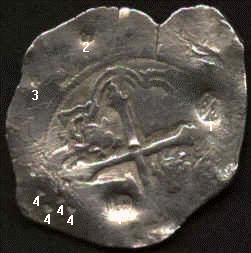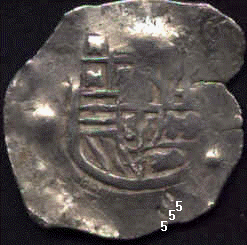Spanish 4-Reale Cob (Phillip IV, 1621-1665)

 Cob-1
Cob-1
Spanish Colonial Mexico, 4 Reale Cob. N.D.
Mint Mark: oM, Assayer Mark: P
Cast in the period of 1634-1665
Weight: 13.4 grams
Chinese chopmarks:
(1) 番 (Fang, in relief, diameter: 4.5 mm): Barbarian
(2) 山 (Shan, in intaglio, diameter<2.0mm ): Mountain
(3) ![]() (Symbol, in
intaglio, diameter<2.0mm)
(Symbol, in
intaglio, diameter<2.0mm)
(4) ![]() (Symbol, in
intaglio, diameter<3.0mm)
(Symbol, in
intaglio, diameter<3.0mm)
(5) ![]() (Symbol, by
engraving, length<3.0 mm)
(Symbol, by
engraving, length<3.0 mm)
This Mexican silver cob carries 11 chopmarks, including 2 Chinese
characters (1,2) and 3 symbols (3,4,5), and is estimated to have circulated in
China during the latter of the 17th century, which was the beginning of the
Ching Dynasty.
The chopmarks are all relatively small; they are all under
4.5 mm in diameter, and mostly 2 to 3 mm in size.
Chopmark (1) carries an interesting message of Chinese merchants'
attitude toward this silver cob. In the Ching Dynasty, the Chinese assumed that
they were living in the only civilized nation which was situated in the center
of the world; foreigners, particularly those people with white skin, blue eyes
and blond hair, were all savages. The Chinese used the discriminatory word
"Fang" (Barbarian) as a name for all foreigners and any fancy
object used or produced by them. This word was frequently found in Chinese
historical papers, but this is the first time it is found used as a chopmark.
The chopmark was used to indicate that this piece is foreign silver, and from
this we can determine that many people in the Ching Dynasty had no idea about
the nature of these strange silver pieces and where they came from.
In addition to the message delivered by Chopmark (1), the
other small chopmarks are assaying chops which assure this cob is not a piece of
silver-plated base metal.
Return to Spanish Colonial Cobs